





Exploring Southwark and discovering its history


Grange Road
Unrecognisable - from the corner with Bacon Grove pre World War I looking east. All the buildings on the left have been demolished and the land is now part of Bermondsey Spa Gardens with the recently built Artesian Building in the distance. On the right, the first few buildings survive, the one on the corner is now an Indian restaurant. The rest have been demolished and mostly replaced with new buildings. St Luke's Church was demolished in 1966 and the land is now a part of Boutcher School's playground. The policeman on the corner has also disappeared.
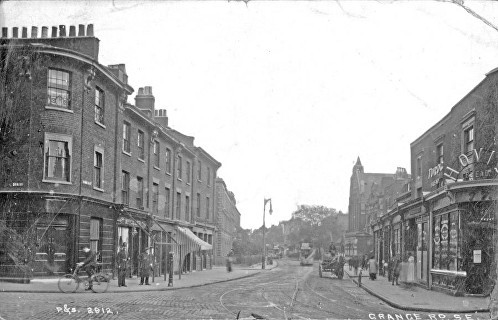
Grange Road, Bermondsey extends eastwards from Tower Bridge Road to Dunton Road (once called Upper Grange Road) where it becomes Southwark Park Road (formerly Blue Anchor Lane). It’s named after the grange, or farm with tithe barns, belonging to Bermondsey Abbey located between, using the street names of today, Grange Road and Spa Road (** see footnote below). Grange Road today is mainly a mix of Victorian housing and more recent apartment buildings, these latter sadly obscuring the road’s history and its once bustling community.
John Roque’s map of 1766 shows the area to be mostly open fields with buildings just lining the street. In what is now Crimscott Street, famous as the location of the former Crosse & Blackwell factory, one of the first botanical gardens was set up in 1772 by William Curtis. He originally trained to be an apothecary with the intention of becoming a doctor but developed an overriding interest in botany, encouraged by Dr John Coakley Lettsom. Curtis was concerned that plants native to the UK were overlooked in favour of the more exotic plants imported from overseas and created a “teaching garden” where indigenous plants were on display. He went on to develop an interest in the medicinal properties of plants and became a demonstrator at the Chelsea Physic Garden and to create the London Botanic Garden on Lambeth Marsh.
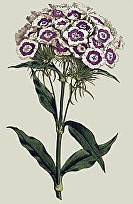
He ventured into publishing, firstly with a six volume work devoted to plants found naturally within a ten mile radius of London. His next endeavour was more successful when in 1787 he launched The Botanical Magazine, beautifully illustrated which gave information about imported plants including their cultivation. The magazine is still published and known as Curtis’s Botanical Magazine. The first urban ecology park was created in 1976 on a disused lorry park in the area around Potters Fields Park and named after William Curtis. When the land was returned to its owner, the ecology park moved to Stave Hill in Rotherhithe.
Bermondsey Spa Gardens is an open space on the north side of Grange Road not far from the site of the original Bermondsey Spa Pleasure Gardens. Thomas Keyse purchased the Waterman’s Arms and about four acres of wasteland in 1765 where he opened a tea garden with benches and arbours where refreshment was taken. In 1770 he discovered, or perhaps invented, a chalybate spring. Artesian springs were popular about this time for the supposed health giving properties of their water. The establishment became known as Bermondsey Spa Gardens and in 1784, having obtained a license for music, £4,000 was spent on improvements in the hopes of rivalling Vauxhall Pleasure Gardens. Sadly it did not reach such heights, mainly because it was out of the way and not easy to get to. It has been described as a “respectable but hardly fashionable resort, which brought its proprietors a moderate income and supplied harmless, if not very exalted, means of recreation.” Thomas Keyse died in 1800 and Bermondsey Spa closed in 1805.
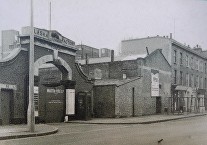
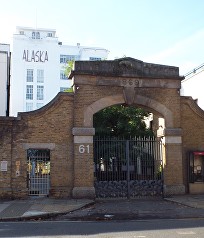
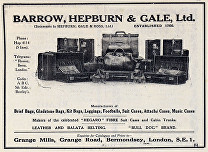
Bermondsey was well known as the centre of the tanning industry and one of the most well known firms was Barrow Hepburn and Gale. The company had achieved its pre-eminence through a series of mergers and amalgamations over a period of 200 years but in 1920 the merger between Samuel Barrow & Brother and Hepburn, Gale & Ross took place to finally arrive at the name Barrow Hepburn and Gale. Their head office address was given as Grange Mills in Grange Road and located at the western end of Grange Road on the south side near the small side turning Woods Place. Grange Mills were very badly damaged during World War II, one report saying it was “damaged beyond repair”. Whether the damage was repaired or the factory was rebuilt, by 1948 Grange Mills was described as a bustling, productive factory. Barrow Hepburn and Gale left Bermondsey in the 1970s.
A little further east is the Alaska Building, a tall bright white 1930s building set back in its own courtyard behind an arch featuring the sculpture of a seal and the date 1869. The arch was built in that year at the same time as the original Alaska Factory where the preparation of fur and, in particular seal skins, highly fashionable in Victorian times, was conducted. FA Schroeter owned the company at that time but it passed to Charles W Martin and Emil Teichmann and seven years later to Charles Martin alone. Some time before he died in 1889, the company became known as C W Martin and Sons.
The seal skin trade declined as a result of a shortage of seal skins due to over-hunting, and Martin’s began to trade more in general furs including their dyeing, cleaning and reconditioning. The present building dates from 1932 and at the outbreak of the Second World War employed 1,100 people. WWII was a busy time for the company when they processed 345,000 sheepskins to be made into flying suits for the RAF and 100,000 linings for flying coats. They also reconditioned 140,000 flying suits for the RAF and 38,000 for the US Air Force in addition to supplying other specialised items for the war effort.
The fortunes of the company declined after the war as the taste and demand for furs fell and the company, that had become Martin Rice Ltd, vacated the Alaska factory. In time, it became a part of the area’s regeneration and was converted into apartments.
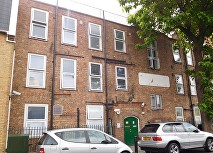
Between the location of Grange Mills and the Alaska factory, on the corner of Grange Road and Crimscott Street (where the Crosse and Blackwell factory was located) was the Bermondsey Medical Mission. Founded by Dr Selina Fox before the creation of the National Health Service, it opened in 1904 and provided for the health of women and children of Bermondsey. For a small fee, the newly opened mission dispensary offered care and treatment to women and children who otherwise were unable to afford medical treatment.
During first 12 months of the Mission opening, there was a total of 22,392 attendances at the Clinic from a total of 5,447 patients and 6,798 visits paid to patients in their own homes. The Mission went through many changes throughout its history and more information can be found here. It became a part of the NHS in 1948 but 10 years later the Mission brought the building back where it provided care for the elderly. Today called Lena Fox House, it is part of St Mungo’s and provides accommodation for the homeless.
A little further east, is the somewhat overpowering Artesian apartment building, the flagship for the ‘Bermondsey Spa’ early 21st century regeneration. Named after the artesian wells, once a visitor attraction in the Bermondsey Spa Gardens next door (see above), it includes a doctor’s surgery. In 1936, before the creation of the National Health Service, a very different health centre was opened just across the road by Bermondsey Borough Council. At a time when Bermondsey suffered poor housing, overcrowding and poverty, the health of Bermondsey’s residents was a priority for the Council. The new Bermondsey Borough Council health centre was built on land cleared when houses at numbers 108, 109 and 110 were demolished. Number 108 had been a municipal TB dispensary which included a light treatment centre, and the house at number 110 had been a municipal lying-in hostel originally funded by the American Red Cross. It had opened in 1919 but as more maternity facilities became available within the borough, including a new, large maternity ward at Bermondsey and Rotherhithe Hospital, demand at the hostel in Grange Road dropped and it was closed in 1923. It became a maternity and infant welfare clinic. For more information see https://ezitis.myzen.co.uk/americanrxmaternity.html
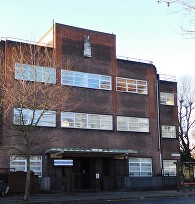
The new health centre contained clinics for expectant mothers and infant welfare and rooms for radiotherapy, X-ray facilities, heat treatment, a foot clinic a dental clinic, and a solarium and dispensary for those suffering from tuberculosis. At a time when the number of people suffering from this disease was high, the treatment and eradication of TB was an important part of the health centre’s work and brought results as cures were effected and incidences of TB reduced in the Borough. The health centre closed in the late 1980s and now houses a GP Surgery.

In 1927, Bermondsey Borough Council built a new public baths and wash-house on the corner of Bacon Grove and Grange Road to replace the original public baths on Spa Road that had become out of date and dilapidated. Housed in a building described by the Council as “an ornament to the borough and one of the best pieces of municipal architecture in London”, there were slipper baths for men and women, two swimming baths, Turkish and Russian baths and a public laundry. The first class swimming bath was 100 feet long and 39 feet wide with a public gallery and rows of teak dressing rooms. In winter the bath was covered over and used for dances, meetings and cinema shows. The public clothes washing facilities included forty drying horses, power driven mangles and electric irons. The building suffered structural damage during World War II but remained open until 1973 when the building was demolished. There are now flats located on the site.
Near Grange Road, overlooking the Bricklayers Roundabout on Old Kent Road, is a large building called Charlotte Court. It is now apartments but before conversion it housed the LCC School for the Deaf. The School’s origins were in a house in Fort Place at the eastern end of Grange Road where the Asylum for the Deaf and Dumb was opened by the Revd. John Townsend of the Jamaica Road Chapel with the assistance of Revd Henry Cox Mason, curate of Bermondsey, and Henry Thornton, MP for Southwark.
A deaf child within Revd. Townsend's parish had been sent by his parents to the privately run Thomas Braidwood’s Academy for the Deaf in Edinburgh. Revd. Townsend was struck by the boy’s keen intellect and agreed with the boy’s mother, Mrs Creasey, there was a need for a charitable institution in London for the education of the deaf. With the support of Mason and Thornton, he opened the Asylum at a time when the educational needs of the deaf were largely ignored. When the school opened there were six pupils whose number increased twice yearly as more pupils were selected by the Committee of Governors of the Asylum. Candidates were between the ages of six and twelve years of age and of “sound mind”. The school quickly outgrew the premises on Grange Road and moved to larger, purpose built accommodation on Old Kent Road in 1809.
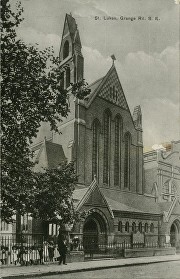
Built in 1885, St Luke’s Church was a prominent landmark on Grange Road. It was situated opposite what are now Bermondsey Spa Gardens and served a parish created from adjoining parts of the parishes of St Mary Magdalen Bermondsey and St James’s. The new church was able to accommodate 300 worshippers, and although bombed during World War II, it was still in use as a church until it was demolished in 1966. The site was absorbed into the Boutcher School and became the school’s playground.
The Boutcher School was built in 1872, replacing the Girls’ and Boys’ parochial schools administered by the parish church of St Mary Magdalen. The Boys’ School had been founded in 1712 when 28 boys were admitted and had been most recently located, until the building of the Boutcher School, in Bermondsey Square. The Girls’ School was founded in 1722, originally in a space over the porch of the church, when initially 20 pupils were admitted. In 1830, the Girls’ School was relocated to a new building in Grange Walk which is still standing and now apartments. By 1841, there were 260 boys attending and 150 girls.
The new school building was paid for by William Boutcher in memory of his wife who died in 1870. It accommodated a total of 700 children – 300 boys, 200 girls and 200 infants. The school is still going strong and still has strong links with the church of St Mary Magdalen.
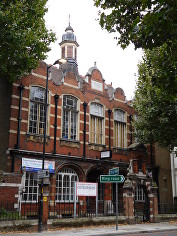
Bacon’s School, at the western end of Grange Road, was also founded by charitable bequest in the 18th century. By the terms of the will of Josiah Bacon, a merchant and native of Bermondsey, his executors were charged with raising sufficient money, not exceeding £700, to purchase land and to build a school where the children admitted “were to be poor children of such persons as should inhabit the parish, whose parents or friends were not able to pay for their learning; and should be there taught, gratis, to read English, and also writing and arithmetic, to fit them for trades, or to keep merchants’ books.”
The school was rebuilt on the same site in 1891 and incorporated a plaque with the inscription:
BACON’S SCHOOL
Founded AD 1703
Built 1718
REBUILT 1891
100 years later the school moved to a new building in Rotherhithe. The London School of Osteopathy now occupies the building in Grange Road.
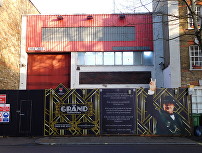
Lastly, a quick note about a building that will soon be disappearing, a non descript building currently (early 2019) surrounded by hoardings. It's on the site of The Grand Cinema that opened in 1914 with 650 seats which reduced to 500 in the 1930s. The cinema closed after World War II. It's difficult to know whether the building incorporates elements from the cinema but it's now awaiting demolition. A new apartment block will be built on the site called, The Grand, Bermondsey.
**Footnote: Whilst the layout has remained quite similar from the 18th century, at that time Grange Road referred to a different road to the one today. The western part of today’s Grange Road was called King’s Road that led east to a fork in the road with Grange Road to the left and Blue Anchor Road to the right. By 1827 King’s Road had been renamed Grange Road and by 1844 the former Grange Road had become as we know it today, Spa Road. It was not until the middle of the 19th century that the roads became known by the names we know them today.
Web discoveries
- UK Casino Not On Gamstop
- UK Casino Not On Gamstop
- Non Gamstop Casino
- Casinos Not On Gamstop
- Non Gamstop Casinos
- Non Gamstop Casinos
- Non Gamstop Casino
- Casinos Not On Gamstop
- Casino Sites Not On Gamstop
- Slots Not On Gamstop
- Casinos Not On Gamstop
- UK Betting Sites Not On Gamstop
- UK Casino Not On Gamstop
- Best Non Gamstop Casinos
- Betting Sites
- Non Gamstop Casino Sites UK
- Best Non Gamstop Casinos
- Non Gamstop Casino
- Casinos Not On Gamstop
- Non Gamstop Casino Sites UK
- Horse Racing Betting